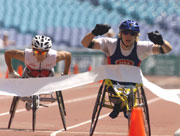|
 Athletics
is one of the most popular Paralympic sports. Athletics was
included in the competition programme of the first Paralympic
Games in 1960 in Rome. It involves the largest number of men and
women athletes and the largest number of events. Athletics
is one of the most popular Paralympic sports. Athletics was
included in the competition programme of the first Paralympic
Games in 1960 in Rome. It involves the largest number of men and
women athletes and the largest number of events.
 Participants
in the Paralympic Games are men and women athletes with cerebral
palsy, spinal chord injuries, amputations or other physical
disabilities, blind athletes and athletes with vision
impairment. The competition programme includes track and field
events, throwing and jumping events, the marathon and
pentathlon. Participants
in the Paralympic Games are men and women athletes with cerebral
palsy, spinal chord injuries, amputations or other physical
disabilities, blind athletes and athletes with vision
impairment. The competition programme includes track and field
events, throwing and jumping events, the marathon and
pentathlon.
Athletes
compete in a wheelchair or using prosthetic legs or arms
(artificial limbs), while blind athletes compete with the help
of a guide.
Athletes
are classified in various classes, based on their type of
disability:
|

|
Athletes
with cerebral palsy are classified in classes 32 to 38.
In classes 32 to 34, athletes compete in a wheelchair,
and in classes 35 to 38 in an upright standing position.
|
|

|
Athletes
with spinal cord injuries or other physical
disabilities, other than cerebral palsy, are classified
according to their mobility profile, in classes 51 to 54
for track events and 51 to 58 for throwing events. In
these classes athletes compete in a wheelchair.
|
|

|
Athletes
with an amputation of one or more limbs, as well as
other physical disabilities (les autres) who compete in
a standing position, are classified into classes 42 to
46.
|
|

|
Athletes
with vision impairment and blind athletes are classified
in the three classes 11, 12 and 13.
|
|

|
Athletes
with dwarfism due to lack of cartilage formation
('achondroplasia') compete only in throwing events, in
category 40.
|
Athletics
at the 2004 Paralympic Games
The
Athletics competition during the ATHENS 2004 Paralympic Games
will take place at the Olympic
Stadium of the Athens Olympic Sports Complex (OCO). The
competition programme will be completed within nine days, from
19 to 27 September 2004.
|








 Participants
in the Paralympic Games are men and women athletes with cerebral
palsy, spinal chord injuries, amputations or other physical
disabilities, blind athletes and athletes with vision
impairment. The competition programme includes track and field
events, throwing and jumping events, the marathon and
pentathlon.
Participants
in the Paralympic Games are men and women athletes with cerebral
palsy, spinal chord injuries, amputations or other physical
disabilities, blind athletes and athletes with vision
impairment. The competition programme includes track and field
events, throwing and jumping events, the marathon and
pentathlon.